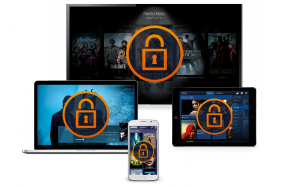
After more than 40 years of operation, DTVE is closing its doors and our website will no longer be updated daily. Thank you for all of your support.
Locking up UHD
 The launch of Ultra HD services are being led by OTT streaming providers, giving rise to additional security concerns. Anna Tobin assesses the industry’s current state of readiness.
The launch of Ultra HD services are being led by OTT streaming providers, giving rise to additional security concerns. Anna Tobin assesses the industry’s current state of readiness.
With Ultra High Definition (UHD) all set to be the next big income generating technology that the TV business has been waiting for, the industry’s locksmiths have their work cut out trying to ensure that the technology is 100% secure. If content travelling along UHD pipes, whether cable, satellite, telco or via OTT, can be stolen or illegally duplicated, the resulting loss of income will cancel out the vast investments that the content providers and operators have made in UHD.
To differentiate UHD from HD, and drive revenue to it, it is being pushed as a premium product, particularly by the major film studios, explains Petr Peterka, chief technology officer at Verimatrix.
“The studios need to establish a new premium content tier with UHD, something that consumers will recognise as qualitatively different from HD and, therefore, be able to demand a higher price for such services. These may be live services or movie-on-demand services, but either way the idea is to create a better experience for the consumer,” says Peterka. “And, as the studios got together and tried to define what that new tier of premium content would look like, they also got together and decided that there better be a new approach to the security of that premium tier, otherwise it would be hard to justify the premiums they are charging for it.”
The security threats to UHD content are really no different to the threats to standard HD content, but OTT, as opposed to traditional linear broadcast, is expected to be the first major market for UHD and the pressure to find secure interoperable solutions across multiple devices is immense. To make matters challenging, although groups such as the UHD Alliance are working hard on this, agreement is yet to be reached on any comprehensive universal standards for UHD.
MovieLabs’ spec
In the absence of a specific UHD standard, the MovieLabs’ Specification For Enhanced Content Protection – which actually covers a whole raft of enhanced content protection from High Dynamic Range through to 4K UHD – has become a blueprint for securing content distributed for the UHD industry. It pays particular attention to content streaming and sharing over the internet, which is seen as a growing threat in the burgeoning OTT market.
“Technology moves very quickly, but so do the pirates or the criminals and the industry has quite a job trying to get ahead of them and minimising the damage. The MovieLabs’ spec represents a good step for today’s technologies and what is realistically possible today and it addresses today’s threats,” says André Roy, head of the security practice at Farncombe.
While it reluctantly accepts that piracy cannot be eradicated completely, the MovieLabs’ spec sets out the major Hollywood studios’ requirements for containing and minimising any threat. And what it has termed as its ‘hack one, only hack one’ proposition is probably its most welcome element. This proposes: “The compromise of security on one platform shall be limited to that platform. And the compromise of security on one distribution of a title shall be limited to that distribution.” Any hack, therefore, should be isolated to the device that it originates from, focusing the security and thus making it easier to trace the offenders and take steps to put them out of action.
As well as prevention, the spec also focuses on what to do if there is a security breach, says Peterka at Verimatrix. “Part of the MovieLabs’ document is about detection: how do you detect that you have a security flaw? How do you know where it is coming from? How do you know which device has a weakness? And, how do you upgrade that device so that the flaw goes away and it becomes secure again?” he says.
The spec itself is not excessively demanding, claims Farncombe’s Roy. “A lot of the technology that is required within the MovieLabs’ specification is already in existence. It’s supported by a number of chipsets, by standards that are in existence and by a number of technology vendors. So, while some aspects of the specification are challenging, in general the industry has the tools at its disposal to implement this specification.”
It will be the operators’ choice of strategic security partner that will impact on how prepared they are for these specs, warns Christopher Schouten, senior director of product marketing at Nagra. “Nagra has been developing and implementing many of the sophisticated CAS and DRM technologies specified by MovieLabs for its tier-1, high-ARPU customers for many years already, especially with regards to secure hardware roots of trust, client diversity and robustness; and, the end-to-end certification and ongoing monitoring of security systems. Nagra customers will be able to embrace and comply with these specs quickly and easily, including, if required, forensic watermarking and related services,” he says.
Technology aside, what is missing from the MovieLabs’ spec is more guidance from the individual studios with regards to which aspects of the spec they each will wish to adopt, says Roy at Farncombe. “We know, from speaking to a number of different studios, that they won’t all be enforcing the full spec, because some studios are much further advanced than others with regards to making UHD content available,” he says.
There will still need to be DRM agreements put in place between the individual service providers and content providers and timing could be a deciding factor, adds Nagra’s Schouten. “For very early release windows,” he predicts, “one would expect a very strong application of MovieLabs’ recommendations, while some requirements might be relaxed for longer tail content. We are also anticipating more pressure within the studios themselves to secure content, with more attempts from pirates to hack their production facilities and steal content, before it even reaches consumers. The unfortunate experience of Sony should be the trigger for serious reconsideration and review of all the protection mechanisms used during the filming and production of the movies.”
Taking the view that you are in permanent conflict with sophisticated criminal entities might help to focus the mind, but history shows that keeping one step ahead of the pirates is not always possible.
To foresee the possible security breaches of the future, it is vital that you look beyond developing the technology to meet the MovieLabs spec, argues Godert Burghard, vice president of global marketing at Irdeto. It is vital to take the pirates seriously, he says. “Technology can counter a lot, but you are always in a cat-and-mouse game with the pirates. At Irdeto we don’t see pirates as individuals who want to steal and copy content. We see them as a real business with a business model and as a real competitor to the operators and content providers,” says Burghard. “As soon as you see what they are doing as a business, you see that the pirates have a value chain from the stages of production, content theft, distribution and consumption.”
When you look at it from this perspective, you have to realise that the pirates are trying to come at the assets from all angles too and you need to have all bases covered. The fragmentation of the industry potentially gives the pirates more break-and-enter points and the operators and content providers more gates to lock up and alarm.
Fragmentation
The fragmentation of the DRM industry is largely a by-product of mixed ecosystems and the lack of global standards. There are four really big fish in the DRM world – Marlin, Microsoft’s PlayReady, Widevine, supported by Google, and Apple’s FairPlay system – plus a few small players.
To cater for all these options, it’s vital to take an agnostic approach towards the technologies that you have to interact with, says Burghard at Irdeto. “Fragmentation doesn’t mean that you have to partner with all kinds of different parties five or six times to support five or six platforms with five or six DRMs,” he says. “It’s about providing an agnostic solution to the market to really make it simple for the operators. If you can do that then the consumer will benefit too as they won’t feel like they have to make changes all the time. And when a consumer has to make changes that can create churn for the operator.”
Established standards such as MPEG-DASH can go some way to simplifying content distribution to multiple devices, but DASH shouldn’t be seen as a panacea, says Schouten at Nagra. “MPEG-DASH’s support for Common Encryption provides substantial reduction in the complexity of both content preparation and packaging workflows for multiple DRM clients,” he says. “[But] Apple’s decision, which could evolve over time, to use and evolve HLS also means that DASH is one of the options to implement, and not the sole solution to consider. While DASH provides an efficient and standardised OTT unicast streaming format, it should not be seen as the panacea that addresses all future TV delivery needs. In the end, the need for hybrid, operator-controlled and robust security solutions prevails, DASH being a welcome enabler for some OTT use cases.”
To avoid having to deal with the ramifications of this fragmentation, Burghard at Irdeto predicts that more and more operators and content providers will begin to call in external experts in DRM security and outsource this side of their business. “The market is getting more complex,” he says, “especially with the lack of standards. So the approach that you need to take is that you address that fragmentation. For example, you might move to HTML5 and MPEG-DASH strategies, but really from an agnostic point of view, being independent of what is actually happening the market.”
There had been concern that fragmentation would also have an impact on the security of platforms and devices used for video playback and that to control this there would be a concentration on distribution through apps as opposed to browsers or the reverse.
This isn’t likely to happen, however, says Schouten at Nagra, “More or less all major consumer device platforms now provide support for baseline video services, either natively or through the support of third-party components and applications. This is a big step forward. Choosing an app or browser model, each with pros and cons in terms of customer experience, is also possible,” he says. “Our approach at Nagra with our MediaLive Secure Player is to provide the key components and apps that enable both options when feasible, as use cases and requirements legitimately differ by customer. Some devices, such as the Xbox, provide proprietary implementations of streaming protocols and DRMs, which can be addressed at the headend, with Nagra’s multi-DRM server solution and with appropriate client apps. So while there are specific solutions required for some devices, advanced OTT TV services can be largely deployed to almost any major devices.”
Social networks are now also moving into live streaming in a big way. Users can now publish video to Twitter, Facebook and Instagram and dozens of other smaller but growing services and the sites encourage this to be done in the walled garden of their apps, rather than on a browser.
“The big discussion these days is how to deal with Meerkat and Periscope,’ says Irdeto’s Burghard. “The Twitter network, for example, can now be used for online video streaming and this is an area, where if you look at certain specifications from the industry, techniques such as watermarking might play a role.”
Burghard says he also wants to see a lot more interaction between distributors of content and rights owners to help safeguard content on emerging distribution networks. “We need to make an effort as an industry,” he says, “to join up together within the ecosystem and go back to Twitter, for example, and the other organisations that support it and say it’s nice that you’ve introduc ed video, but please work with the security vendors out there to ensure that you don’t end up [wrongly] distributing content that has rights attached to it.”
ed video, but please work with the security vendors out there to ensure that you don’t end up [wrongly] distributing content that has rights attached to it.”
Tagging content with watermarks that leave an indelible trail showing which devices and which eyeballs it has shown up at across the world is one solution that hackers are already trying to chip away at. It might not be economical for the small rights owners to keep a track of their content in this way, however. There will be a lot of companies that could struggle to keep control of their rights.
Taking a more upbeat position, Roy at Farncombe, says that while some areas are becoming more complex, in some ways the workings of the industry are becoming simpler and this should make working within it easier and possibly more cost effective. “There is a very strong evolution taking place in terms of technology where a lot of the chipset manufacturers today are delivering more end-to-end solutions that take away some of the complexity of implementation. So yes there is more complexity, but there are also more off-the-shelf solutions available and fundamentally the chipset manufacturers’ technology has come a long way and this does give a good leg up to people who are developing systems as well,” he says.
Audience analytics
Winning the war on piracy isn’t just about making the content secure, it’s also about closely monitoring pirated content to see how to stem the demand for it. This is where audience analytics, particularly for OTT content, come into their own. By highlighting suspicious key requests and false device authentications, they can provide a strong indication that there is unauthorised use of content and illustrate fraudulent usage patterns across all devices.
“At Nagra,” says Schouten, “we’ve chosen a Secure Player approach to ensure that all the key client security requirements are consistently addressed across all platforms. The Secure Player goes beyond the DRM or streaming format used and addresses specific security needs with sophisticated software techniques, such as Whitebox cryptography, secure video paths, and sunrise key change as well as software obfuscation and hardening to ensure the proper client implementation of the DRM module and the overall security of the client platform.”
By monitoring piracy behaviour it is also possible to discover new income streams, points out Burghard at Irdeto. “If you understand how the pirate business model helps the consumption of pirated content through the consumer, you can kind of see why the consumer is doing that in the first place.
“Typically what we see is that there is usually a cost issue involved or that the consumer is frustrated that they cannot get the content legitimately, even though it has been released in other windows by the industry or in other territories. This information can help operators to make decisions that will attract that consumer away from the piracy spectrum into the legitimate spectrum. We always say that you cannot compete with free, but you can compete with easy. If we, as an industry, can make it really easy for consumers to get their hands on the content that they want on the devices that they want, then that might move them away from the pirate services.”
US-based Netflix launched in Australia largely to provide an easy and affordable service to the large amount of consumers who they recognised were already going down the piracy route. In turn, this opened up a whole new income stream for Netflix. But this move illustrates how, in a response to content distribution being possible worldwide, piracy has moved from being a local problem to a global one.
“As far as security is concerned, to be able to respond to any particular threat on a global scale, not just on a local scale, we see as a very important change in the landscape,” says Peterka at Verimatrix. “One of the things that we anticipate with our more connected security vision is that we will be able to monitor the state of the world in a much more comprehensive fashion going forward and be able to see attacks on a system in one part of the world and potentially do something about it, before the whole world catches the cold.”
By monitoring where content is going and knowing when it is going where it shouldn’t, it should be possible to contain the threat and stop it in its tracks. This is the theory that the MovieLabs’ spec is based around and that any emerging UHD standards are likely to follow. Whether that theory works in practice will be tested increasingly forcefully over the next few years as UHD takes hold on the market.


